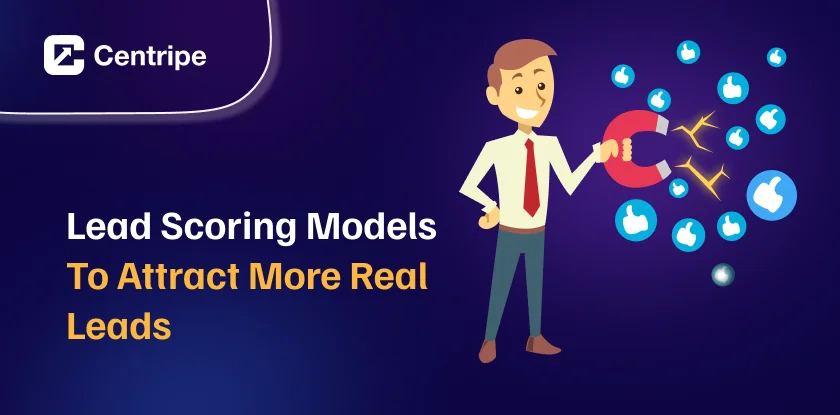‘Still guessing which leads are worth your time?’
You are not alone…..
Many teams rely on gut feeling…. But that only works when you have a few leads. As your pipeline grows, you need a smarter system.
That’s where…
The lead scoring models help you identify which leads are most likely to convert into buyers. It separates the hot prospects from the cold ones.
Companies that use lead scoring see 77% higher conversion rates and reduce their sales cycle by 23%.
So, let’s get started and learn about those models.
What Are Lead Scoring Models?
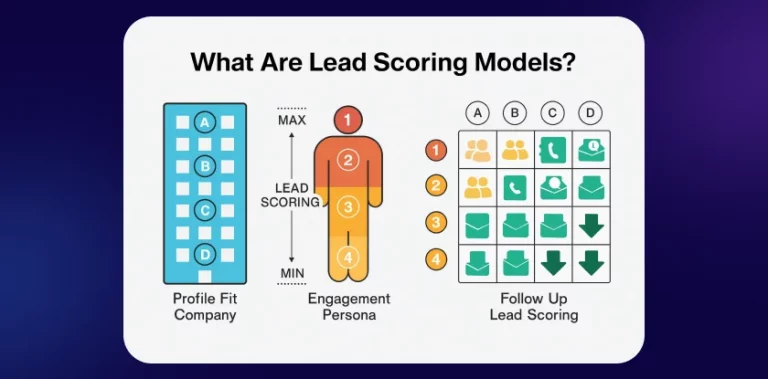
Lead scoring models mean figuring out which leads are worth investing time in. It uses real data to rank your prospects, allowing your sales team to focus on the most promising leads.
Here’s the breakdown on which score is given:
- Explicit data: What the lead tells you about themselves (Job title, company size, etc.)
- Implicit data: What their actions tell you (page views, downloads, email opens
You combine both above types into one score. The higher the score, the hotter the lead, allowing your team to act quickly and close more deals.
Types of Lead Scoring Models & Choose Your Perfect Fit
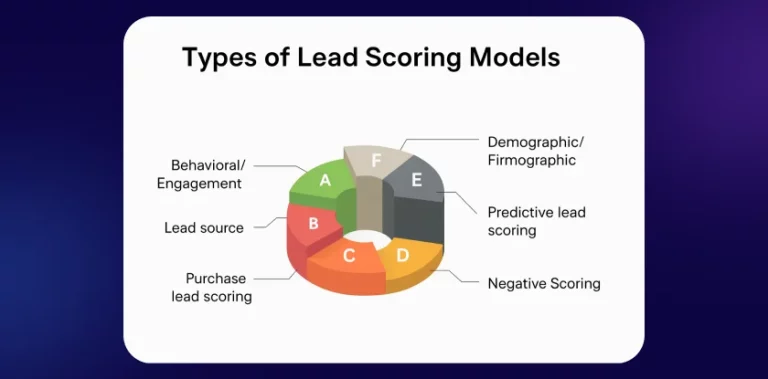
No single model works perfectly for everyone. Every successful B2B company I’ve worked with combined different scoring methods and chose the approach that works best for them.
Let’s look at those different types of models and which one is best for you.
Comparison of Lead Scoring Models
| Model Type | Best For | Key Advantages | Implementation Difficulty |
|---|---|---|---|
| Demographic/Firmographic | Companies that know their ideal customers | Easy to implement | Low |
| Behavioral/Engagement | Online-focused businesses | Dynamic Scoring | Medium |
| Lead Source | Teams using multi-marketing channels | Channel Optimization | Low |
| Purchase Intent | Businesses with long and complex sales | High accuracy | Medium |
| Predictive lead scoring | Companies with a lot of leads | Self-optimizing | High |
| Negative Scoring | All businesses | Prevents false positives | Low |
1. Demographic/Firmographic Model:
This is the foundation model, known as explicit scoring, because it uses the information that leads give you directly. The score in this model is based on the information they provide, such as their background, company details, or other relevant details.
Demographics are used in B2C companies (you need information like age, location)
Firmographics are used in B2B companies (you need information like job title, industry, and company size).
You can collect this information through lead forms, just by asking a few smart questions like:
- Job title
- Industry
- Company size
- Why are you reaching out? (intent-based multiple-choice)
Best for: Companies that know their ideal customer and have access to good data to identify them.
Example Scoring:
| Attribute | Criteria | Score | What it means |
|---|---|---|---|
| Job Title/ Role | C-Suite executive | +30 | Top decision-maker |
| Director | +20 | Senior leader | |
| Manager | +10 | Mid-level manager | |
| Company Size | 500-1000 employees | +25 | Ideal company size |
| Industry Fit | In your target industry | +20 | Matches the industry you serve |
2. Behavioral/Engagement Model:
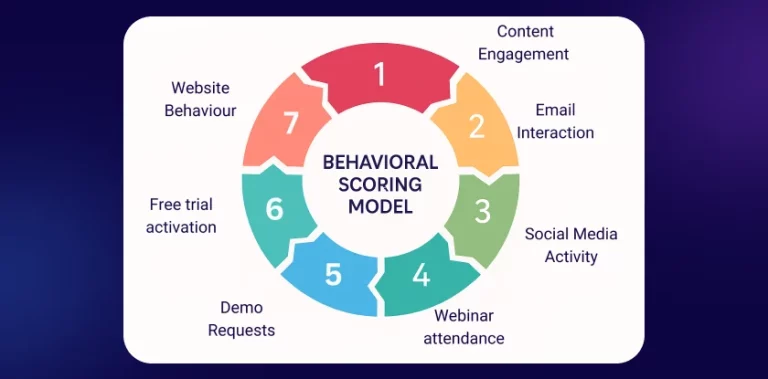
This model helps you spot the most interested buyers by tracking their actions, not just what they say. It gives points for behaviour that shows genuine interest in your products.
What really shows interest. Things like:
- website behavior (Do they visit key pages, stick around, or keep coming back?)
- Content engagement (what they download, videos they watch, calculators they play with)
- Email interactions (opens, clicks, and yes, forwards count big time)
- Social media activity (Are they active, liking, sharing, commenting on your posts?)
- Webinar attendance (Do they show up to your events?)
- Demo requests (huge buying signal)
- Free trial activation (Have they started using a free trial?)
Best for: Companies with solid online presence and effective marketing automation.
Example scoring:
| Action | Points Given | What it means |
|---|---|---|
| Visits the pricing page | +15 | Serious interest |
| Downloads case study | +10 | Researching your solution |
| Request a product demo | +50 | Ready to buy soon |
| Attends a webinar | +20 | Wants to learn more |
| Clicks emails (each time) | +5 | Engaged with your content |
3. Lead Source Model
This model focuses on scoring leads based on their origin, identifying which marketing channels yield the most valuable prospects. It helps you focus on leads from sources that are more likely to convert.
Key Lead source scoring criteria:
- Organic search
- Paid ads
- Social media
- Content marketing
- Partner referrals
- Direct traffic
- Event signups
Best for: Teams managing multiple channels who carefully track the origin of each lead.
4. Purchase Intent Model
The purchase intent model focuses on identifying leads who are actively seeking to purchase, rather than simply browsing your products or services.
How to spot high purchase intent:
- Examine what your top past customers did before they made a purchase.
Give more points for these actions:
- Downloading important resources or guides
- Visiting key pages several times
- Using tools like the ROI calculator
- Searching for or reading about competitors
- Looking at vendor or pricing information
- Reading budget-related content
Best for: Businesses with complex sales processes where buying decisions take longer and involve multiple people.
5. Predictive Lead Scoring Model
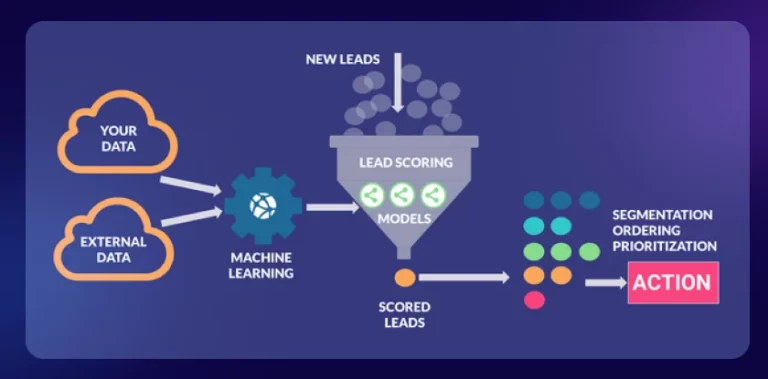
This model uses AI to analyze hundreds or thousands of information about your leads. It finds patterns that humans might miss to figure out which leads are more likely to buy your products or services.
According to Gartner, predictive scoring can boost qualification accuracy by up to 30%.
Key advantages:
- Self-adjusting models
- Real-time updates
- Detect hidden patterns
- No human bias
Best for: Companies with a lot of leads and strong data systems that want to prioritize time and effort on the most promising prospects.
6. Negative Scoring Model
This model helps you remove or deprioritize leads that show signs of low interest or are unlikely to convert, allowing you to focus on more promising opportunities.
Common reasons to lower a lead’s score:
| Negative Trigger | Points Deducted | Reason/Explanation |
|---|---|---|
| Email Unsubscribers | -50 | Leads is no longer interested |
| Career page Visit | -20 | Likely job seeker, not buyers |
| Student email | -30 | Usually not a buying prospect |
| Competitors employee | -100 | Not a suitable lead |
| Radio Silence for 90+ days | -25 | Leead has been inactive or unresponsive |
Final Thoughts
It’s time to stop guessing and start scoring…
Because in 2025, time and accuracy matter more than anything. Therefore, don’t waste your energy chasing the wrong leads.
Your best customers are out there….. Use the above lead scoring models to focus on the right leads.
So, select the one that best suits your business. Or mix a few to get better results.
